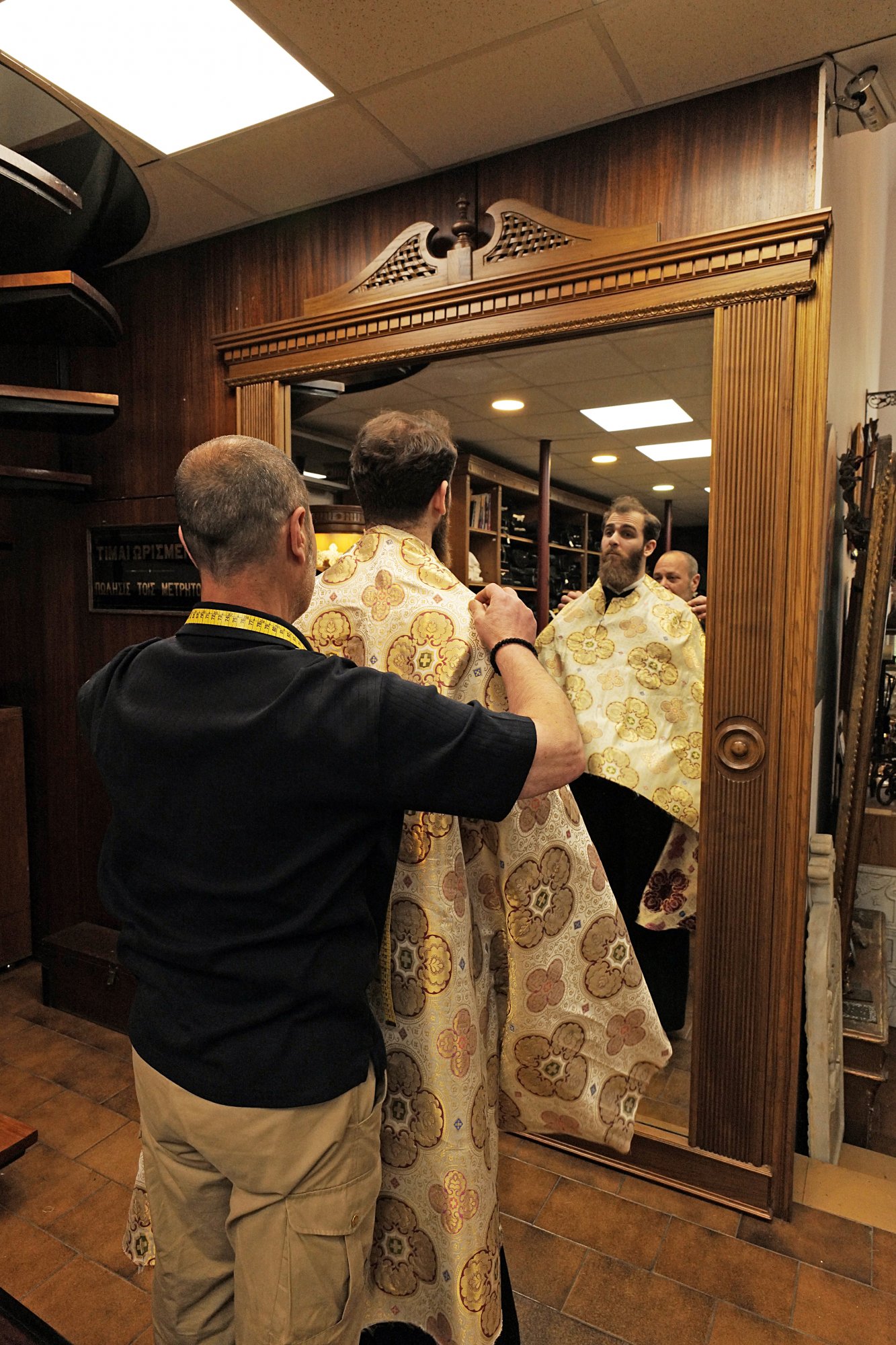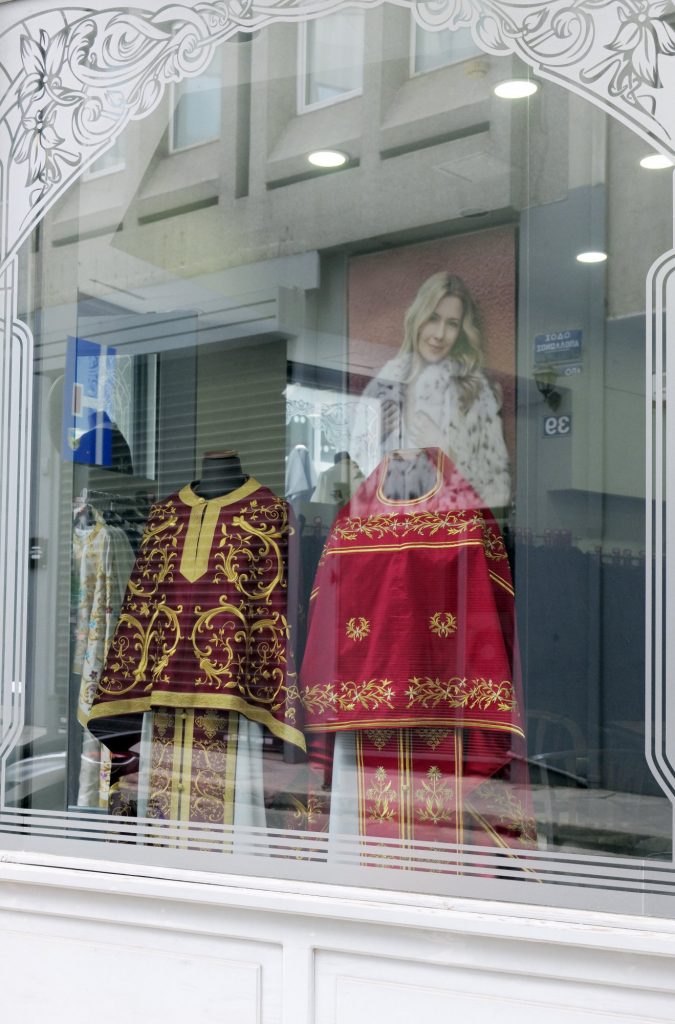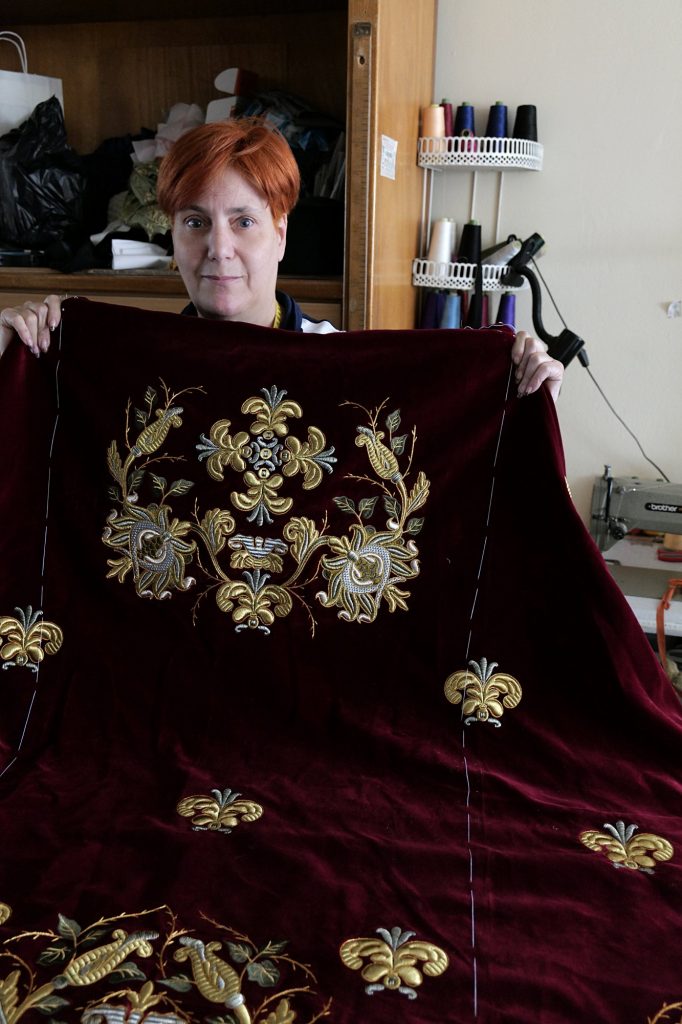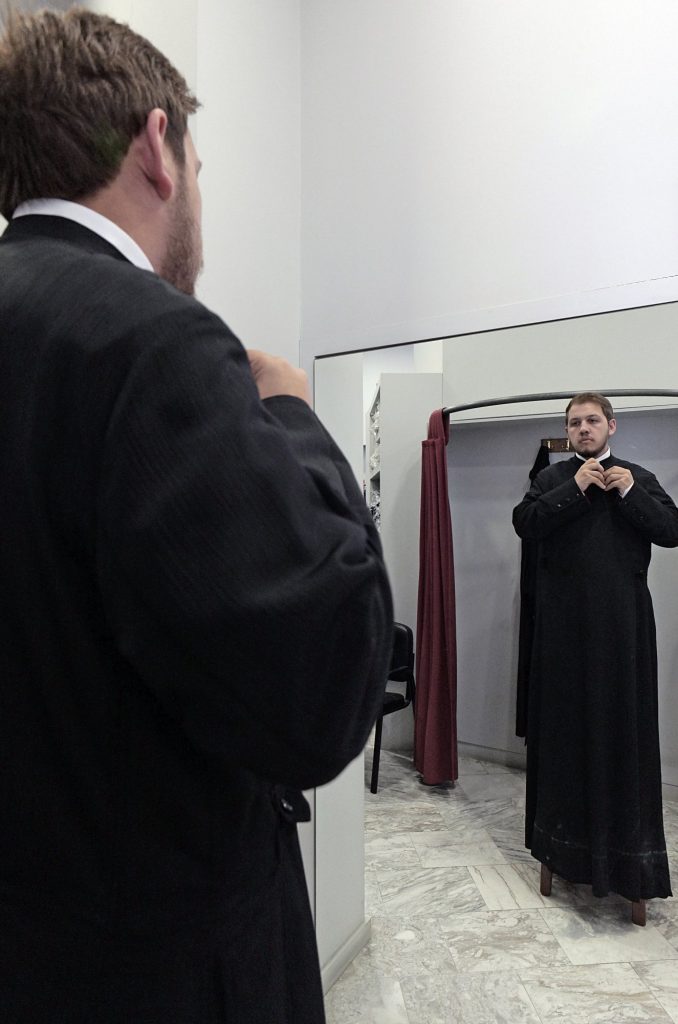It’s the quiet that hits you first. You may be in Athens’ commercial triangle, an area where a new hotel is being built on every street and the pavements are furrowed from the wheels of tourist luggage, but the ecclesiastical tailors of downtown Athens seem somehow to inhabit their own time. They live their days in accordance with the ecclesiastical calendar celebrating Christ’s works and days—a cycle of life and death that has continued without interruption for millennia. Opening very early indeed and generally closing round noon, even their operating hours are in sync with an alternative daily reality,. As for their clientèle, it is both guaranteed and independent of the vagaries of tour operators and tourist ministry advertising campaigns. For as long as there are churches, there will be priests, and as long as there are priests, there will be a need for robes and vestments to clothe them.
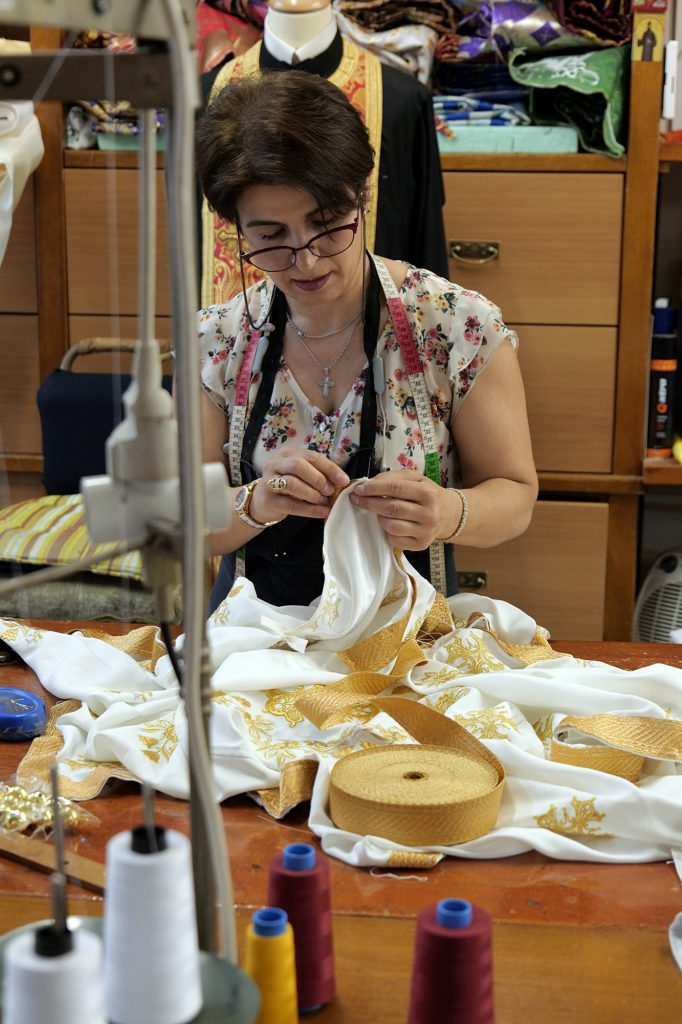
The Kastanias workshop started up in Gyzi just after the war. |Later, it moved to Athens’ commercial triangle. Photo: Nikos Kokkas
The tailors unfurling the bolts of cloth on the bench, meticulously marking out the measurements required to sew a robe and following their lines on the sewing machine, have been providing the same important service for millennia. Dressing the men who have been charged with the ministry of the word of God, they are part of a truly miraculous symbiosis.
The workshops are an organic part of the ecclesiastical ecosystem that thrives around Apollo Street in the shadow of Athens Cathedral, and which also includes purveyors of ecclesiastical art, icon workshops and haberdasheries specializing in priestly fabrics.
“We have been providing our services here since 1907,” says Mr. Panagiotis Theodoropoulos, the owner of the Theodoropoulos Ecclesiastical Sewing Workshop, one of the oldest and most historic in the sector. His grandfather learned the art in Constantinople, then later moved to Athens and opened up shop in the area to serve the clergy in the cathedral and surrounding churches. “The books say that the nuns from the convent of Saint Narrational on Regina would also come here for their robes.”
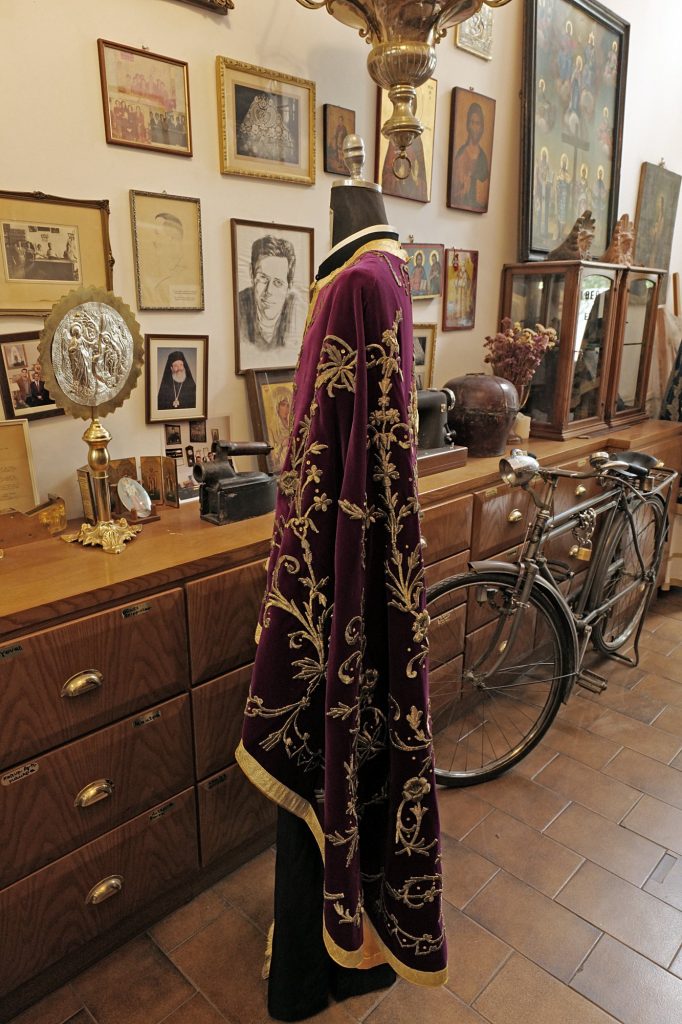
The Theodoropoulos Workshop was founded in 1907. It has a long and rich history in the manufacture of priestly vestments. Photo: Nikos Kokkas
Even today, it’s not out of the question that some future saint will walk through the door of one of the ecclesiastical sewing workshops in the city center, which are visited by priests at every level and from all four corners of the world. In this business, the reputation a business earns within church circles is all important, and a good name is spread exclusively by word of mouth.
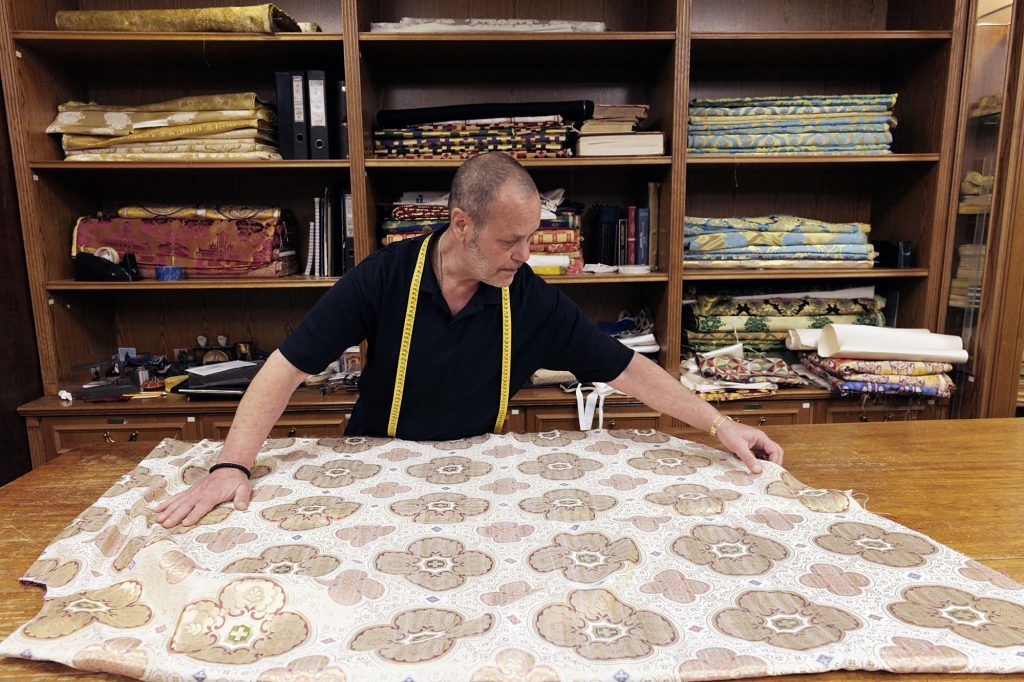
Panagiotis Theodoropoulos’s grandfather learned the art of ecclesiastical tailoring in Constantinople. Photo: Nikos Kokkas
“In addition to the quality of the work, how long a particular workshop has been established is another key factor in its eligibility,” explains Mrs. Katerina Kastania, who, along with her brother, are the third generation of tailors to work at the Kastanias workshop. The business was set up in Gyzi shortly after the war by their uncles, who visited nearby churches to hand out business cards and establish a clientèle. “My brother and I grew up surrounded by fabrics and sewing machines. No one taught us the job, we picked it up by observing everything that was going on around us.”
Robes are not only essential for priests, they are also expensive. The most economical solutions start at 400-500 Euros. “Many people imagine these expenses are covered by the church or that a subsidy is provided,” notes Mrs Alexandria Tani from the Chilton ecclesiastical sewing workshop and vestment manufacturers, the first workshop to offer ready-made priestly robes and vestments. “We pay for them out of our own pockets,” explains Father Stefanos Karamouzis, a priest from Chalkida Cathedral, who has travelled to Athens for a special occasion: to help Father Anthimos Papakonstantinos, a deacon in the same church, acquire his first robe.
On average, from their ordination on and depending on their rank, priests will have two vestments made a year and should have around ten different sets of vestments in their wardrobe for the specific feasts and sacraments they are expected to preside over. “A priest needs to put money aside to buy his robes,” Father Stefanos admits.
“We’re shopping therapy for priests,” Mrs. Kastania notes. “They can’t go shopping to the mall —it’s to us here they come.” As customers, they’re no different from the laity. “Some are very cooperative, but others are more abrupt, impolite or impatient,” says Mrs. Tani. Still, she does say that priests take more care over their appearance than lay people. “It take a newly-ordained priest a couple of months to get used to wearing the robes, but they’ll notice certain details right away, like how long it is, how it falls and how it feels on their neck.”
As Mr Theodoropoulos sees it, it makes sense for priests to want to present a clean and neat appearance to their congregations. “I also think,” he adds, “that people want to see their priest wearing a beautiful vestment as he conducts the liturgy.” But there is a very fine line between a garment serving its function and evoking vanity in the wearer.
“I think the time when priests would purchase expensive vestments so as to stand out is over,” Father Stefanos notes, adding: “Young priests may be more susceptible, but they come back down the earth very fast.” The reality is that an expensive robe not only invites negative comments, it also reveals an inconsistency: “How can a priest talk about solidarity and helping our fellow men when he walks around in a luxurious robe?” asks Father Stefanos, who believes that simple robes are appropriate because they do not offend the sensibilities of the faithful.
Mrs. Tani adds that, apart from quality and experience, confidentiality also plays an important role in a workshop gaining a clientele. “If I talk about any special requests a client may have made, people will have every reason to wonder what all of this has to do with spirituality.” Finally, Mrs Kastania add that, as in all commercial transactions, “the customer is not always right.” On the other hand, “let us not forget that priests are only human—they also have their sins and weaknesses,” Mr. Theodoropoulos notes.
The process of sewing a robe is a somewhat overlooked and humble aspect of the church’s ministry, which is performed in the main by anonymous female hands. It culminates in an experience common to clergy and laity alike: when we stand in front of the mirror and reveal our true selves trying on our new clothes for the first time. Though the Greeks have a proverb which sats “The robe doesn’t make the priest,” Athens’ ecclesiastical tailors know for a fact that they do: without robes, there can be no priest…
